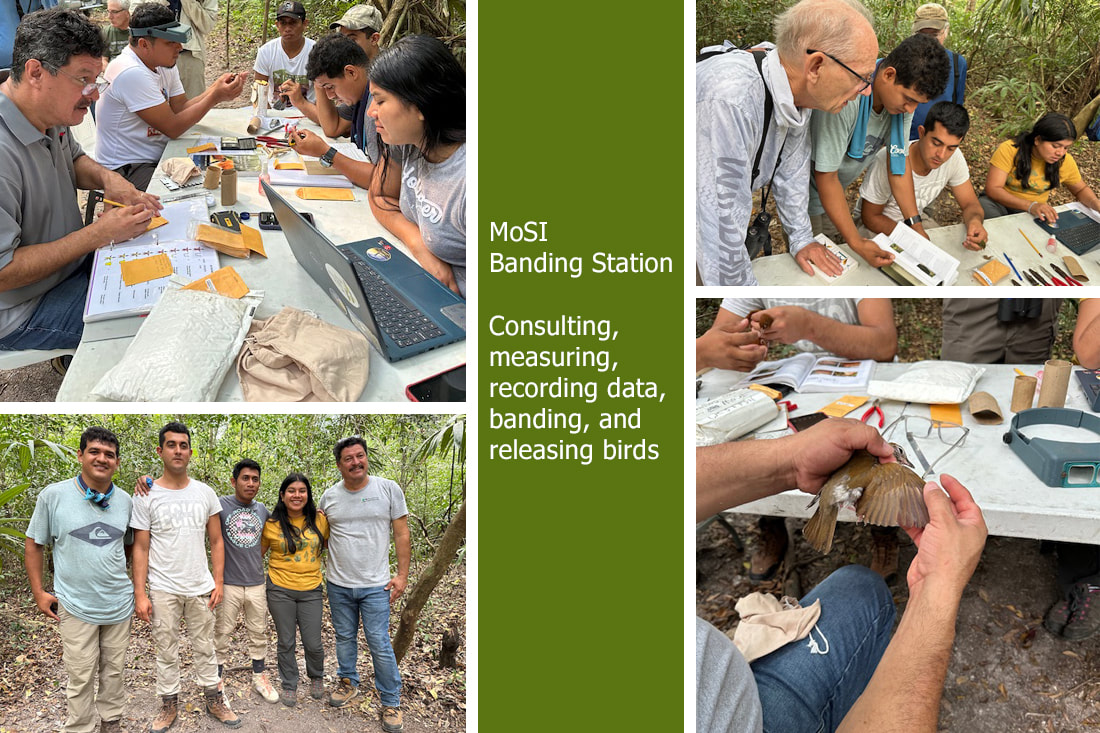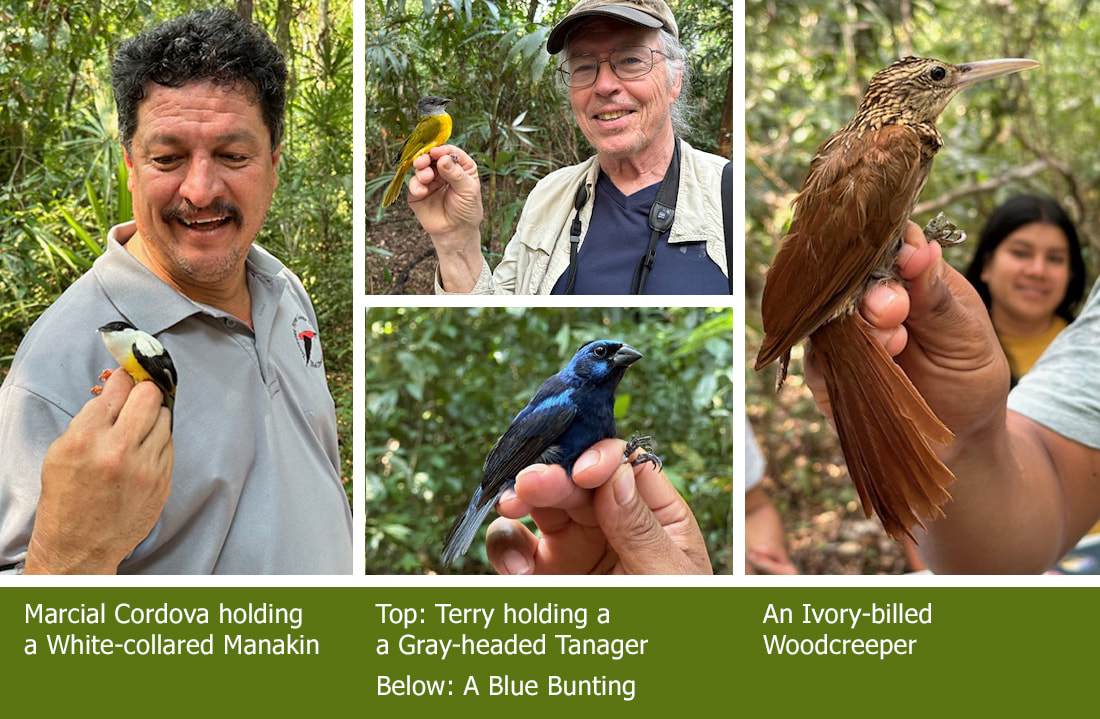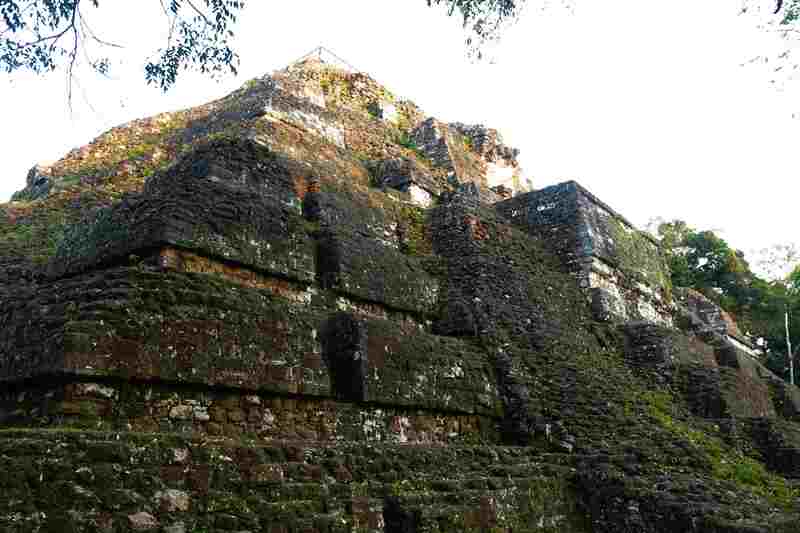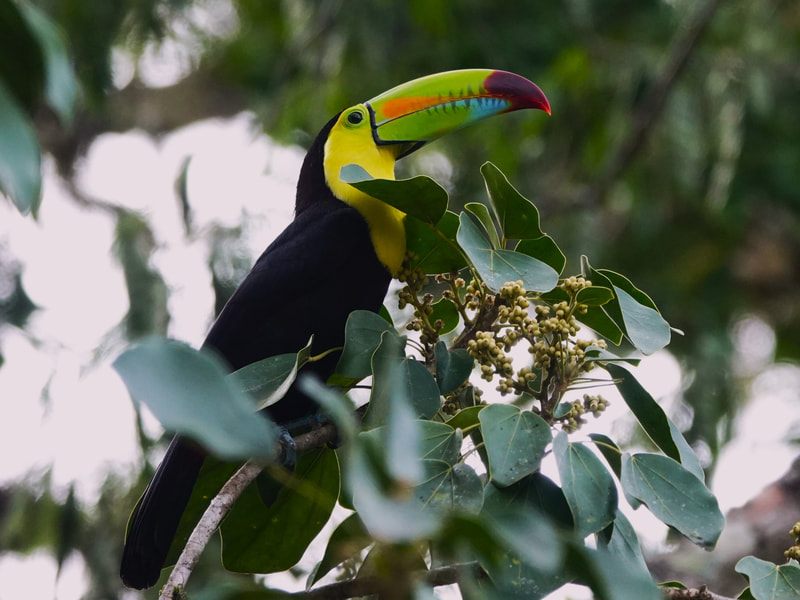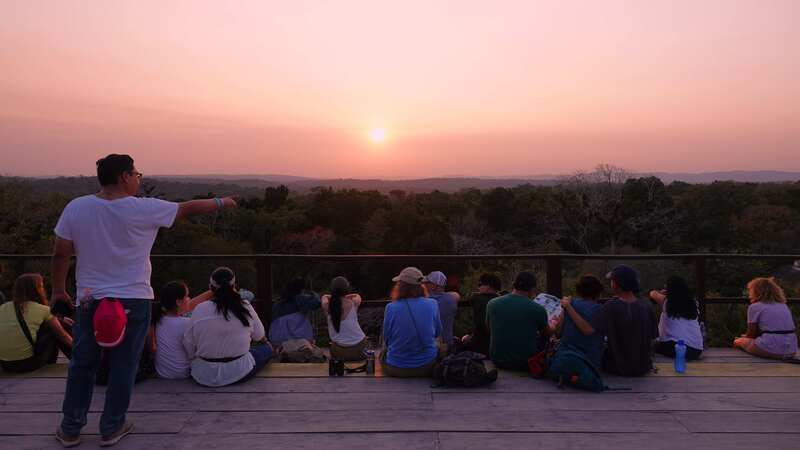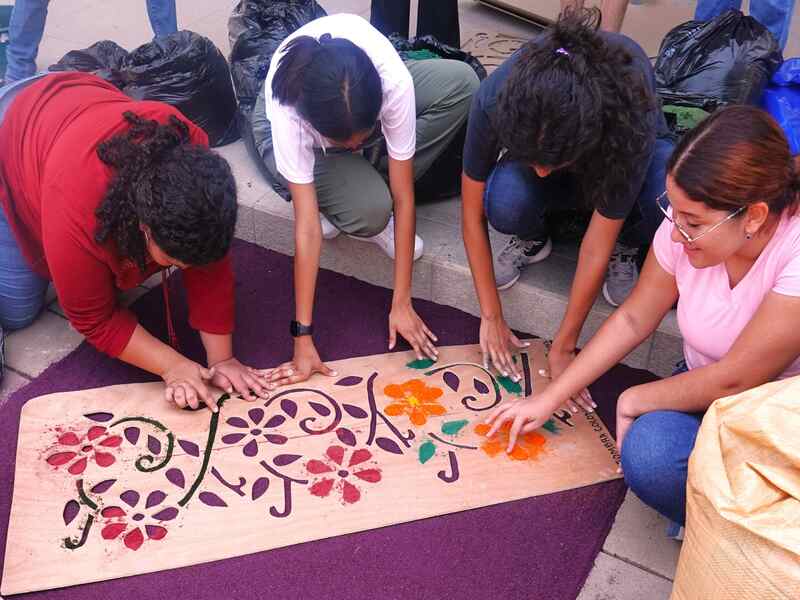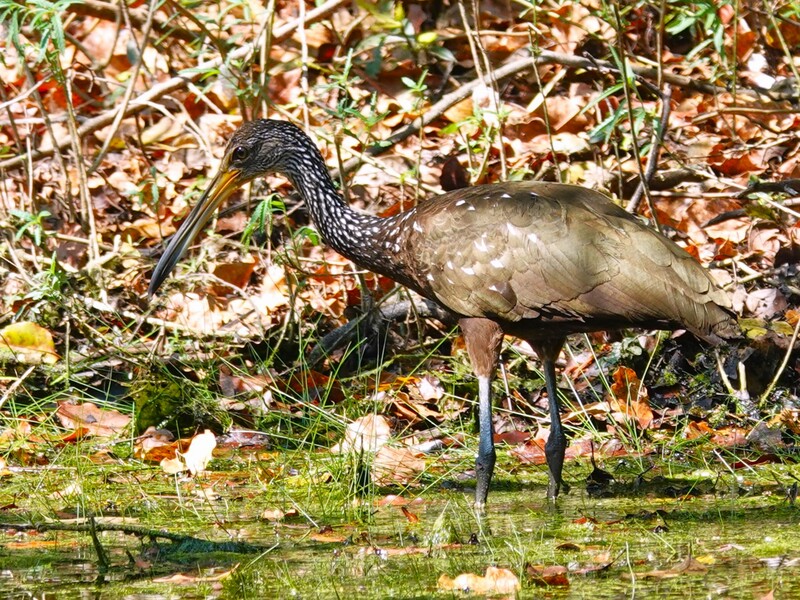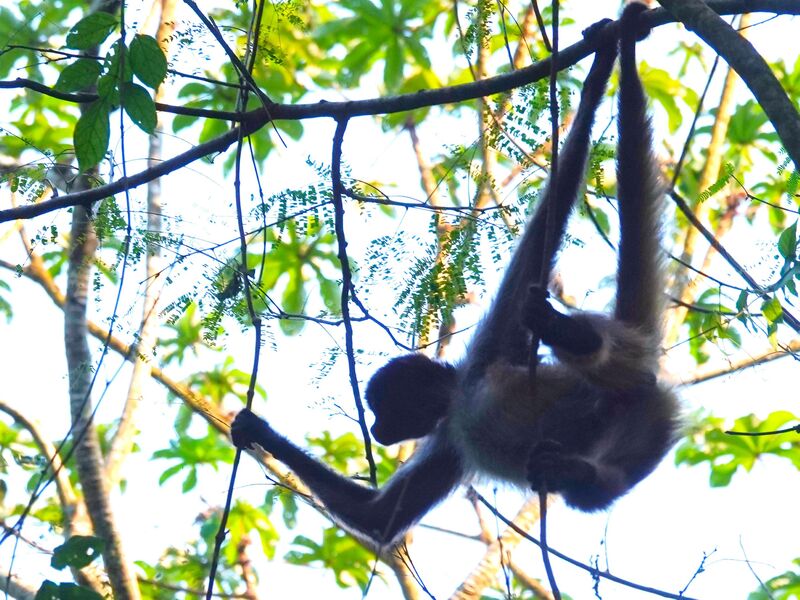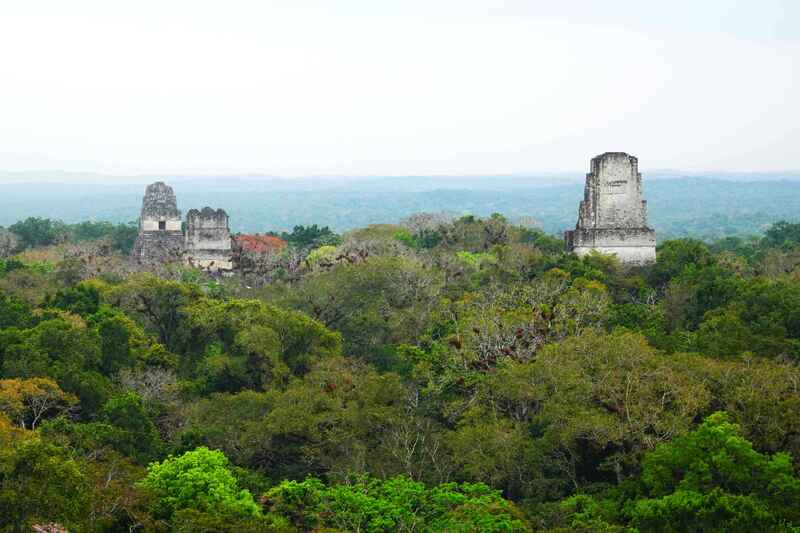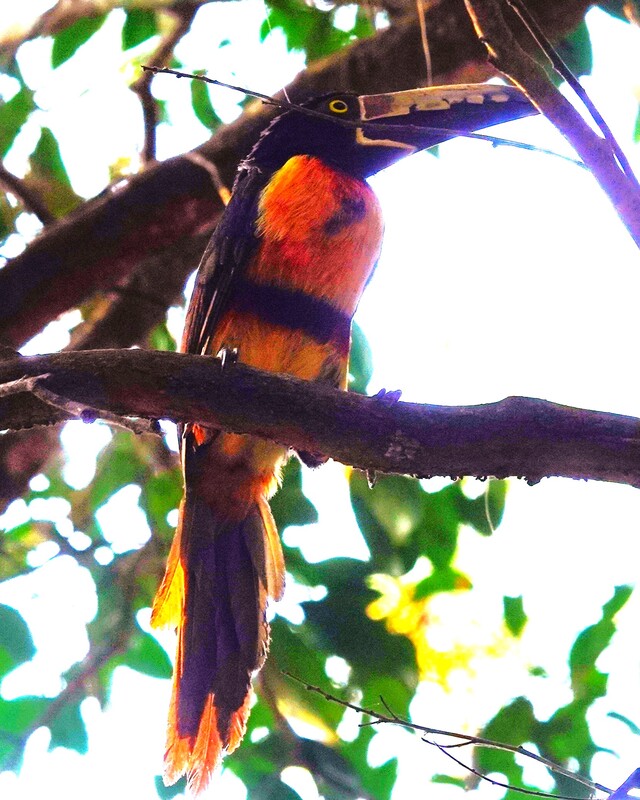NEWSLETTERS ~ CURRENT NEWS ~ BUTTERFLY COUNT ~ CHRISTMAS BIRD COUNT ~ NATIVE PLANTS & PRAIRIE ~ VOLUNTEER
Monitoring Migrating Birds in Guatemala - March 2024
ZVAS volunteers travel to Central America with two main goals: erecting a MOTUS Tower and assisting at a MoSI Bird Banding Station ... but they also had a lot of fun along the way!
First up – the MoSI banding station.
Zumbro Valley Audubon has been making financial contributions to a “MoSI” station in Guatemala since 2020. MoSI is an acronym for Monitoreo de Sobrevivencia Invernal, or Winter Survival Monitoring program. It consists of 150 stations in 22 countries, is run by The Institute for Bird Populations (birdpop.org) and monitors neotropical migratory birds on their wintering grounds. A dedicated volunteer team led by Marcial Cordova bands birds each year from November through March in two national park locations in northern Guatemala, Uaxactun in Tikal National Park, and EBG – La Laguna de Tigre National Park.
On this trip our team visited the Uaxactun (Wash-ack-toon) location, where 15 nets were set up at 6 am on three consecutive days. Nets were checked hourly from 7 to 11 am, at which time birds were removed and taken to a central location. The volunteer banders determined each bird’s species, estimated its age, measured the wing chord, weighed the bird, rated its fat reserves, and checked its brood patch before finally releasing the banded bird. Resource books were consulted often with a great deal of collaboration between the banders. Data was entered into a computer on site. More information about the MoSI programs can be found at birdpop.org. In the near future, MoSI will begin tagging some migrating songbirds at the banding sites of the ZVAS partners in this part of Guatemala.
Many species which can be seen in Minnesota each summer were caught while we visited. These included: Gray Catbird, Wood Thrush, Indigo Bunting, Ovenbird, plus Black-and-white, Magnolia, Kentucky, and Hooded Warbler. This is the first year that MoSI has allowed the banding of resident birds, not just the North American migrants, so we were happy to see up close a very colorful Red-capped Manakin, a White-collared Manakin, a small Stub-tailed Spadebill (not often seen by birders), and an impressively large Ivory-billed Woodcreeper that looks like a bigger version of our tiny Brown Creeper.
First up – the MoSI banding station.
Zumbro Valley Audubon has been making financial contributions to a “MoSI” station in Guatemala since 2020. MoSI is an acronym for Monitoreo de Sobrevivencia Invernal, or Winter Survival Monitoring program. It consists of 150 stations in 22 countries, is run by The Institute for Bird Populations (birdpop.org) and monitors neotropical migratory birds on their wintering grounds. A dedicated volunteer team led by Marcial Cordova bands birds each year from November through March in two national park locations in northern Guatemala, Uaxactun in Tikal National Park, and EBG – La Laguna de Tigre National Park.
On this trip our team visited the Uaxactun (Wash-ack-toon) location, where 15 nets were set up at 6 am on three consecutive days. Nets were checked hourly from 7 to 11 am, at which time birds were removed and taken to a central location. The volunteer banders determined each bird’s species, estimated its age, measured the wing chord, weighed the bird, rated its fat reserves, and checked its brood patch before finally releasing the banded bird. Resource books were consulted often with a great deal of collaboration between the banders. Data was entered into a computer on site. More information about the MoSI programs can be found at birdpop.org. In the near future, MoSI will begin tagging some migrating songbirds at the banding sites of the ZVAS partners in this part of Guatemala.
Many species which can be seen in Minnesota each summer were caught while we visited. These included: Gray Catbird, Wood Thrush, Indigo Bunting, Ovenbird, plus Black-and-white, Magnolia, Kentucky, and Hooded Warbler. This is the first year that MoSI has allowed the banding of resident birds, not just the North American migrants, so we were happy to see up close a very colorful Red-capped Manakin, a White-collared Manakin, a small Stub-tailed Spadebill (not often seen by birders), and an impressively large Ivory-billed Woodcreeper that looks like a bigger version of our tiny Brown Creeper.
Next - erecting a Motus Radio Receiver Station.
While bird banding is a wonderful way to track birds, it’s limited in that you have to recapture the bird to figure out where it’s been. Now science has developed tiny “radio backpacks” that can be attached to migrating birds. When these birds fly within eight miles of a receiving tower their presence is recorded and scientists can better track the birds throughout their journey. More of these towers are needed and one of Zumbro Valley Audubon’s goals was to provide funding for a receiving station tower.
In support of that goal, four ZVAS board members along with two other volunteers traveled to Tikal National Park in northern Guatemala in March 2024 to deliver equipment, help assemble the antennas, and assist with the installation of a Motus radio receiver in the park. This tower, with six antennas receiving two different frequencies, will automatically pick up signals from birds that have been fitted with the tiny backpack radio transmitters. Data collected will increase our knowledge of bird movement and facilitate research and conservation efforts.
ZVAS board member Eric Matteson coordinated many virtual meetings and managed the ordering, purchasing and shipping of equipment via hundreds of emails and other communications to make this cross-border, multi-entity private and public, cross-cultural installation happen. (Thank you Eric!)
Once the gear was assembled, we watched as the installer climbed the tower and worked 80 feet above ground for five hours straight in 100+ degree temperatures to attach the antenna. An additional hour was needed the next day to secure the cables and get everything ready to receive signals.
Motus (Latin for movement) is a coordinated automated radio telemetry program supported by many conservation organizations to facilitate research and education on the ecology and conservation of migratory animals. Data are publicly available for review and research. As part of Motus, our station now joins a network of 123 stations tracking birds migrating from the United States to South America and back via the Yucatan Peninsula and Gulf of Mexico.
The receiver went active March 27, 2024. You can go to Motus.org to learn more about this Birds Canada program and see data from the new tower.
Many thanks also go to …
Generous contributions from ZVAS members helped fund this collaborative effort. Expertise and leadership of personnel from the World Conservation Society Guatemala, and staff from the Tikal National Park including Rony Garcia-Anleu, Hebert Humberto, Chen Tesucun, and especially Colorado Springs volunteer Michael Rogers and his wife Rebecca were critical to the success of this endeavor. The contributions of many others, including Josh Sayers of Birds Canada, Luis Pinelo, Executive Administrator of Tikal National Park who secured permission for installation of the Motus equipment near the Park Headquarters, and other WCS personnel including Gabriela Ponce and Anna Lello Smith and particularly Julio Morales, who shepherded the equipment through Guatemalan Customs were essential to the success of the installation.
Click on each photo above to see the entire photo and caption.
And while we were there …
A couple of years ago we invited Marcial Cordova, head bander at the MoSI station we have allied with, to visit us in Minnesota. We took him to a few birding spots (he saw his first ever Black-capped Chickadee here) and forged a relationship we hope lasts for many years.
On this trip to Guatemala, Marcial generously supported us by providing transportation, facilitating our activities, and accompanying us on outings. We also hired a very knowledgeable, English-speaking guide to lead us around the large, extensively restored Mayan ruins of Tikal National Park. Dating from 800 BC to 900 AD it includes six of the largest pyramid temples in Central America and hundreds of other buildings. Howler monkeys (the loudest of all monkeys) impressed us with their calls, spider monkeys swung through the jungle canopy, a highly venomous Fer-de-Lance snake slithered across our path, and numerous birds were added to our lists. We watched the sunset from the top of one of the pyramids and climbed the largest pyramid, Temple IV, where we observed an Orange-Breasted Falcon feasting on prey in a nearby tree. Our guide Pablo Mujarillo is the site manager of a reintroduction program at Tikal sponsored by The Peregrine Fund, which is much like the Peregrine Falcon program at the Mayo Clinic in Rochester.
In the charming colonial town of Flores, we watched a Good Friday procession and saw an elaborate 20’ by 200’ street “carpet” that almost looked like a painting, but was created using brightly dyed sawdust that took many people 24 hours to create.
A visit to Yaxha National Park near the Belize border provided another large-scale example of Mayan ruins that had a population at of 70,000 in 700 AD, and which had good birding for us, including a White-fronted Parrot at its nest.
Birds of note:
While the main goal of our trip was not birding, we did make time to see at least some of the many species native to Guatemala. With the help of our guides we found 100 species of birds, including such interesting ones as: Boat-billed Heron, Limpkin, Ocellated Turkey, Great Curassow, Red-lored Parrot, White-fronted Parrot, Collared Aracari, Keel-billed Toucan, Pale-billed and Lineated Woodpeckers, Plain Chachalaca, Northern Potoo, 3 types of Trogons, Green Jay, Brown Jay, Purple Martins nesting in a tree, Social Flycatcher, Great Kiskadee, Montezuma Oropendola, Strong-billed Woodcreeper; Black & White, Magnolia, and Worm-eating Warbler, Ovenbird, Baltimore and Orchard Oriole, and Melodious Blackbird. Other animals that were also seen were an Aguti, many Coati Mundi, a Crocodile, and a Tyra Barbara (a kind of weasel).
Photos by Joan Leof & Terry Grier. Report by Joan Leof, Eric Matteson and Terry Grier.
Please note that ZVAS funds were used for the purchase, transportation and installation of the Motus tower equipment. Volunteers paid for their own travel, lodging, meals and miscellaneous expenses.
